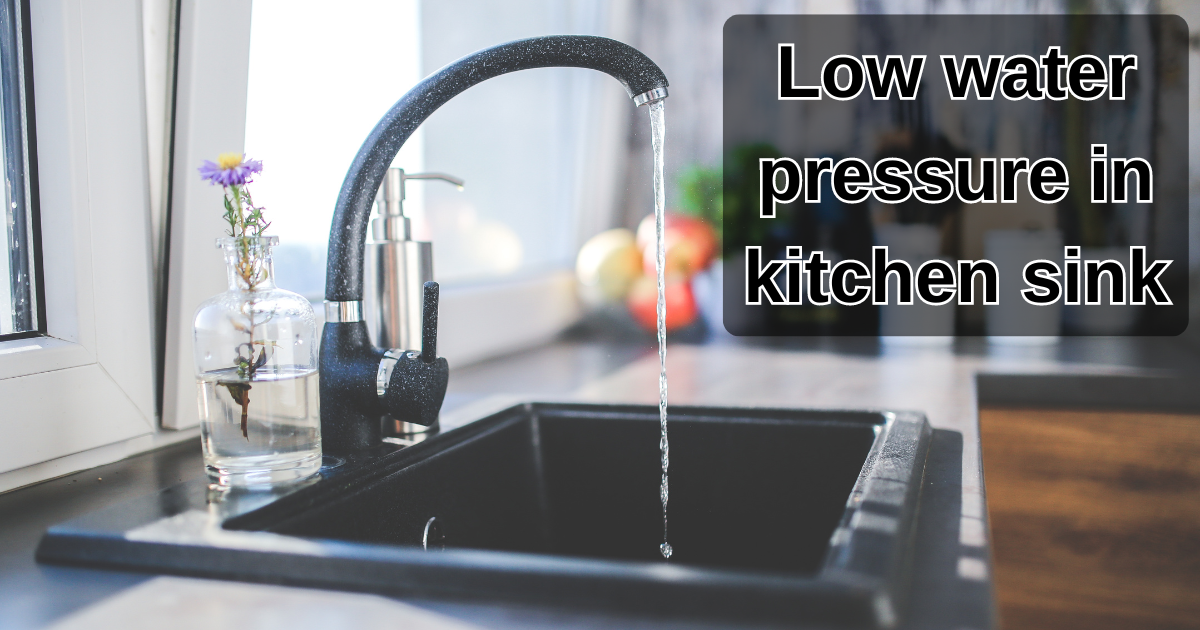Low water pressure in kitchen sink is a common issue where the flow of water from the faucet is reduced below the normal rate. This can lead to frustration, especially when performing daily tasks like washing dishes or filling pots. The problem is not only inconvenient but can also indicate underlying plumbing issues that need attention. Low water pressure in kitchen sink can be caused by a variety of factors, ranging from minor clogs to significant pipe damage. Understanding what low water pressure in kitchen sink is and how it affects your daily activities is the first step towards effectively addressing the issue.
Importance of Addressing Low Water Pressure
Addressing low water pressure promptly is crucial for maintaining the functionality of your kitchen sink and overall plumbing system. If left unresolved, low water pressure can lead to more severe plumbing problems, such as pipe leaks or bursts. Additionally, low water pressure can impact the efficiency of your household tasks, making simple activities like washing hands or dishes more time-consuming and cumbersome. By identifying and fixing the root causes of low water pressure, you can prevent potential damage to your plumbing system and ensure that your kitchen sink operates at optimal performance.
Overview of Common Causes
Low water pressure in kitchen sink can be attributed to several common causes. These include clogged aerators, mineral build-up in pipes, leaking pipes, faulty pressure regulators, and issues with the municipal water supply. Each of these factors can contribute to reduced water flow and affect the overall performance of your sink. Understanding these causes helps in pinpointing the exact issue and applying the appropriate solution. In the following sections, we will delve deeper into these causes, provide troubleshooting steps, and offer solutions to effectively address low water pressure in your kitchen sink.
Identifying Low Water Pressure
Symptoms of Low Water Pressure in Kitchen Sink
The most noticeable symptom of low water pressure in kitchen sink is a reduced flow of water from the faucet. You may observe a thin, trickling stream of water instead of a strong, steady flow. Additionally, the problem may be localized to one faucet or affect multiple faucets throughout your home. Other signs include inconsistent water flow, strange noises from the faucet, or slow filling of the sink. Identifying these symptoms early can help in diagnosing the issue and preventing further complications. Regular observation of your water pressure can assist in timely intervention and maintenance.
How to Test Water Pressure Levels
Testing water pressure levels is essential in diagnosing low water pressure issues. You can use a simple water pressure gauge, which is available at most hardware stores. To test, attach the gauge to the faucet and turn it on to measure the pressure. A normal water pressure reading typically ranges from 40 to 60 psi (pounds per square inch). If the reading is significantly lower, it indicates a problem with your water pressure. Alternatively, you can test the pressure at different faucets to determine if the issue is isolated to one sink or affects the entire plumbing system. Accurate measurement helps in identifying whether the problem is local or systemic.
Common Causes of Low Water Pressure in Kitchen Sink
Clogged Aerators and Faucets
Clogged aerators and faucets are among the most common causes of low water pressure in kitchen sinks. Aerators are small devices attached to the end of the faucet that mix air with the water flow to reduce splashing and improve efficiency. Over time, these aerators can become clogged with debris, sediment, and mineral deposits, leading to restricted water flow. Cleaning or replacing the aerator can often resolve the issue. Simply unscrew the aerator from the faucet, clean it with vinegar or a brush, and reattach it. If the aerator is severely clogged or damaged, replacing it with a new one may be necessary to restore proper water flow.
Mineral Build-Up in Pipes
Mineral build-up, also known as limescale, is another common cause of low water pressure. Hard water contains minerals such as calcium and magnesium, which can accumulate inside pipes over time. This build-up narrows the pipe diameter and restricts water flow, resulting in reduced pressure at the faucet. To address mineral build-up, you may need to flush the pipes with a descaling solution or install a water softener to prevent future accumulation. Regular maintenance and water treatment can help manage mineral build-up and maintain optimal water pressure in your kitchen sink.
Leaking Pipes and Fittings
Leaking pipes and fittings can significantly impact water pressure by allowing water to escape before it reaches the faucet. Leaks can occur due to damaged pipes, loose fittings, or corrosion. Symptoms of leaks include damp spots under the sink, water stains, or a noticeable decrease in water pressure. To address leaks, inspect the pipes and fittings for any signs of damage or corrosion. Tighten any loose connections and replace damaged sections of the pipe. For persistent leaks or extensive damage, it is advisable to consult a professional plumber to ensure a thorough and effective repair.
Faulty Pressure Regulator
A faulty pressure regulator can also lead to low water pressure in your kitchen sink. The pressure regulator is a device that controls the water pressure coming into your home from the main supply. If the regulator is malfunctioning or set too low, it can result in reduced water pressure throughout the house. Checking and adjusting the pressure regulator requires some technical knowledge, and it is often best handled by a professional plumber. They can assess the regulator’s condition, make necessary adjustments, or replace it if needed to restore proper water pressure.
Municipal Water Supply Issues
Sometimes, low water pressure is not related to your plumbing system but to issues with the municipal water supply. Factors such as high demand, water main breaks, or maintenance work can affect water pressure in your area. If you suspect that the problem is due to municipal supply issues, contact your local water utility company for information and assistance. They can provide details on any ongoing issues or disruptions in service and offer guidance on how to manage low water pressure until the problem is resolved.
Troubleshooting Low Water Pressure in Kitchen Sink
Step-by-Step Guide to Diagnosing the Problem
Diagnosing low water pressure involves a systematic approach to identify the root cause. Start by checking if the issue is isolated to one faucet or affects multiple fixtures. If it’s only one faucet, the problem may be with the aerator or faucet itself. Remove the aerator, clean it, and test the water pressure again. If the problem persists, inspect the faucet for internal issues. For issues affecting multiple fixtures, the problem may be with the main water supply or pipes. In such cases, check for leaks, mineral build-up, or issues with the pressure regulator. A thorough inspection helps in pinpointing the cause and applying the right solution.
Tools Required for Troubleshooting
To troubleshoot low water pressure effectively, you will need a few basic tools. A water pressure gauge is essential for measuring the pressure levels and diagnosing the problem. Additionally, a set of pliers, wrenches, and screwdrivers will be useful for removing and cleaning aerators, tightening fittings, or replacing damaged parts. For more advanced troubleshooting, a pipe inspection camera can help in detecting hidden issues within the pipes. Having these tools on hand allows for a comprehensive assessment and resolution of low water pressure issues in your kitchen sink.
When to Call a Professional Plumber
While many low water pressure issues can be resolved with DIY methods, some problems require professional expertise. If you have attempted to troubleshoot the issue and the problem persists, or if you encounter complex issues such as extensive pipe damage or faulty pressure regulators, it is time to call a professional plumber. A licensed plumber has the experience and tools needed to diagnose and fix more challenging problems efficiently. They can also provide expert advice on maintaining optimal water pressure and preventing future issues.
Fixing Low Water Pressure in Kitchen Sink
Cleaning Clogged Aerators
Cleaning clogged aerators is often a straightforward solution for low water pressure in the kitchen sink. To clean an aerator, first, unscrew it from the end of the faucet. Soak the aerator in a mixture of vinegar and water to dissolve mineral deposits and debris. Use a small brush or toothbrush to scrub away any remaining residue. Rinse the aerator thoroughly and reattach it to the faucet. Once reinstalled, turn on the faucet to check if the water flow has improved. Regular cleaning of aerators can prevent clogs and maintain proper water pressure.
Flushing and Cleaning Pipes
Flushing and cleaning pipes can help resolve issues caused by mineral build-up and debris. To flush pipes, turn off the main water supply and drain the water from the pipes by opening the faucets. Use a descaling solution to dissolve mineral deposits and pour it into the pipes. Allow the solution to sit for the recommended time, then flush the pipes with clean water. This process helps clear out any build-up and restore proper water flow. Regular pipe maintenance can prevent blockages and ensure consistent water pressure in your kitchen sink.
Also Read: How to Become a Notary in Michigan
Repairing Leaks in Pipes and Fittings
Repairing leaks in pipes and fittings is essential for maintaining proper water pressure. To fix leaks, start by locating the source of the leak. Inspect the pipes and fittings for any signs of damage, corrosion, or loose connections. Tighten any loose fittings and replace damaged sections of the pipe as needed. For more extensive leaks or significant damage, consider using pipe repair kits or consulting a professional plumber. Addressing leaks promptly prevents water loss and helps maintain optimal water pressure in your kitchen sink.
Adjusting or Replacing the Pressure Regulator
Adjusting or replacing a faulty pressure regulator can resolve issues with low water pressure. To adjust the pressure regulator, locate the adjustment screw, usually found on the regulator itself. Turn the screw to increase the pressure to the desired level, typically between 40 and 60 psi. If adjusting the regulator does not resolve the issue, or if the regulator is damaged, replacement may be necessary. Consult a professional plumber to ensure proper installation and calibration of the new regulator to restore adequate water pressure.
Addressing Issues with Municipal Water Supply
If low water pressure is due to municipal water supply issues, contact your local water utility company for assistance. They can provide information on any disruptions or maintenance work affecting water pressure in your area. In some cases, the issue may be temporary and resolve on its own. However, if low water pressure persists, the utility company may offer solutions or updates on the situation. Staying informed about municipal water supply issues helps manage expectations and plan accordingly.
Preventing Low Water Pressure in Kitchen Sink
Regular Maintenance Tips
Regular maintenance is key to preventing low water pressure issues in your kitchen sink. Perform routine checks of your faucet and aerator to ensure they are clean and functioning properly. Inspect pipes and fittings for any signs of leaks or damage. Schedule periodic professional plumbing inspections to address potential issues before they become major problems. Regular maintenance helps keep your plumbing system in good condition and ensures consistent water pressure.
Importance of Water Softening
Water softening can play a significant role in preventing low water pressure caused by mineral build-up. Hard water, which contains high levels of calcium and magnesium, can lead to the accumulation of limescale inside pipes and fixtures. Installing a water softener can help reduce the mineral content in your water, preventing build-up and maintaining optimal water flow. Regularly servicing and replacing the water softener ensures its effectiveness in managing water hardness and preserving water pressure.
Monitoring Water Pressure Over Time
Monitoring water pressure over time allows you to detect changes and address issues early. Use a water pressure gauge to periodically check the pressure levels at your kitchen sink and other fixtures. Keeping track of any fluctuations or drops in pressure can help you identify potential problems before they escalate. Implementing a monitoring routine can aid in maintaining consistent water pressure and ensuring the efficient operation of your kitchen sink.
FAQs
What Causes Low Water Pressure in a Single Faucet?
Low water pressure in a single faucet can be caused by several factors, including a clogged aerator, sediment build-up, or issues with the faucet itself. If only one faucet is affected, start by inspecting and cleaning the aerator. If the problem persists, check for sediment or debris in the faucet or consider replacing it. If necessary, consult a plumber to diagnose and resolve the issue.
How Can I Prevent Future Low Water Pressure Issues?
Preventing future low water pressure issues involves regular maintenance and monitoring. Clean aerators regularly, flush pipes to remove mineral build-up, and inspect pipes and fittings for leaks. Installing a water softener can help manage mineral content in hard water. Regular professional plumbing inspections can also help identify and address potential issues early.
Is Low Water Pressure a Sign of Bigger Plumbing Issues?
Low water pressure can sometimes be a sign of more significant plumbing issues, such as leaks, pipe damage, or problems with the water supply. While minor issues can often be resolved with simple fixes, persistent or severe low water pressure may indicate underlying problems that require professional attention. If you are unsure or unable to resolve the issue, consulting a licensed plumber can help ensure a thorough assessment and proper resolution.
Conclusion
Low water pressure in kitchen sink can be caused by various factors, including clogged aerators, mineral build-up, leaking pipes, faulty pressure regulators, and municipal water supply issues. Identifying the symptoms, diagnosing the problem, and applying appropriate fixes are crucial for managing low water pressure in your kitchen sink and maintaining optimal water flow. Regular maintenance, monitoring, and professional inspections can help prevent future issues and ensure the efficient operation of your kitchen sink.
Managing low water pressure in kitchen sink requires a proactive approach to identifying and addressing potential causes. By understanding common issues related to low water pressure in kitchen sink and implementing effective solutions, you can maintain consistent water flow and avoid more significant plumbing problems. Regular maintenance and professional inspections play a vital role in preserving the functionality of your plumbing system and ensuring that your kitchen sink operates smoothly.










